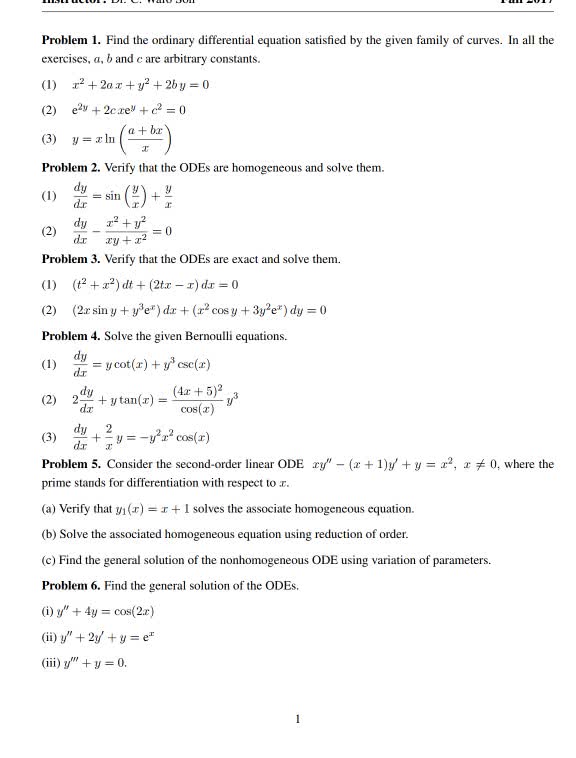MATH 2412 Lecture Notes - Lecture 7: Convolution Theorem, Linear Algebra, Quadratic Equation

University of Leeds MATH 2375
Linear Differential Equations and Transforms
Chapter 1
Some General Theory of Ordinary Differential Equations
1Introduction
A substantial part of the current module is to develop further techniques for solving linear
ordinary differential equations (ODEs). Almost all of our examples will be second order,
but the techniques are easily generalised to higher order equations.
Whilst most of our time will be spent developing techniques for solving an equation, it
is important to understand the basic theorem on existence and uniqueness of solutions and
a few basic properties of the structure of the solution space.
2ExistenceandUniqueness
Consider the second order equation
d2y
dx2+p(x)dy
dx +q(x)y=0,(1)
with p(x),q(x) continuous on some interval I, given by a≤x≤b.
Whether or not you can actually find a solution to this ODE, you may like to plot the
graph of some solution (ie numerically integrate it). You might like to know that you have
not set your computer an impossible task! It’s not enough to just give the equation, since it
has “too many” solutions (the general solution). We need to specify an initial value problem.
The next theorem tells us that there actually exists a solution for the computer to plot and
that there is only one such solution.
Theorem 1 (Existence and Uniqueness) Consider the differential equation (1), with
p(x),q(x)continuous on some interval I,givenbya≤x≤b.Letα,βbe any two real
numbers and x0be any point in the interval I.Thentheequationhasauniquesolution,
defined on the interval I,whichsatisfies
y(x0)=α, y′(x0)=β.
Since equation (1) is, linear and homogeneous, its solution set forms a vector space.
Since it is second order, the dimension of this space is 2. Any two independent solutions
y1(x),y
2(x) can be used as a basis. The general solution is given as the linear superposition
y(x)=c1y1(x)+c2y2(x),c
1,c
2arbitrary constants.
Theorem 1 says that c1,c
2can be fixed by specifying initial conditions.
1
find more resources at oneclass.com
find more resources at oneclass.com

Remark 2 (Boundary Conditions) It is also possible to fix c1,c
2by specifying 2−point
boundary conditions,suchasy(0) = y(1) = 0,butinthiscasewedonothavesucha
powerful, general theorem, telling us that a (nontrivial) solution always exists. We discuss
such boundary conditions in Chapter 3.
Remark 3 (Why only 2 Initial Conditions?) The equation implies that
y′′ (x)=−p(x)y′(x)−q(x)y(x)for any x∈I.
In particular
y′′ (x0)=−p(x0)y′(x0)−q(x0)y(x0),
so y′′ (x0) cannot be independently specified.
3TheWronskian
Given
y(x)=c1y1(x)+c2y2(x)andy(x0)=α, y′(x0)=β,
we have apairoflinearequationsfor c1,c
2:
c1y1(x0)+c2y2(x0)=α
c1y′
1(x0)+c2y′
2(x0)=β!⇒"y1(x0)y2(x0)
y′
1(x0)y′
2(x0)#"c1
c2#="α
β#,
so, to calculate ci, we require
y1(x0)y′
2(x0)−y′
1(x0)y2(x0)=$$$$
y1(x0)y2(x0)
y′
1(x0)y′
2(x0)$$$$
̸=0.
Definition 4 (The Wronskian of Two Functions) Given two functions y1(x),y
2(x),we
define the Wronskian
W(x)≡W[y1,y
2](x)=y1(x)y′
2(x)−y′
1(x)y2(x).
Lemma 5 (Abel’s Formula) Let yi(x)be solutions of
d2y
dx2+p(x)dy
dx +q(x)y=0.
Then
W′(x)=−p(x)W(x)and so W(x)=W0exp "−%x
x0
p(ξ)dξ#.(2)
Proof
From Definition 4, we have
W′(x)=y1(x)y′′
2(x)−y′′
1(x)y2(x),
=y1(x)(−p(x)y′
2(x)−q(x)y2(x)) −(−p(x)y′
1(x)−q(x)y1(x))y2(x)
=−p(x)(y1(x)y′
2(x)−y′
1(x)y2(x)) = −p(x)W(x).
Therefore (defining W0=W(x0))
W′(x)=−p(x)W(x)⇒W(x)=W0exp "−%x
x0
p(ξ)dξ#.
!
2
find more resources at oneclass.com
find more resources at oneclass.com

3.1 Linear Dependence
Two functions y1(x),y
2(x)arelinearly dependent if there exists γ̸=0,suchthaty2=γy1.
In this case
W[y1,y
2]=$$$$
y1y2
y′
1y′
2$$$$
=$$$$
y1γy1
y′
1γy′
1$$$$
=0,
since the two columns are proportional for all x.
Do we have the converse statement that “W[y1,y
2]=0 ⇒y2=γy1”? Here is a
counter-example:
Example 6 (Counter-example to converse statement) The two functions y1=x3
and y2=|x|3are linearly independent, but W[y1,y
2]≡0. To prove linear independence,
can we find c1,c
2(not both zero), such that c1y1+c2y2= 0? Evaluating this at x=1and
x=−1:
c1y1(1) + c2y2(1) = c1+c2=0,c
1y1(−1) + c2y2(−1) = −c1+c2=0 ⇒c1=c2=0,
proving linear independence.
But for x<0wehavey2=−y1so W[y1,y
2]=0forx<0. Also, for x≥0wehave
y2=y1so W[y1,y
2]=0forx>0.
However, the converse statement does hold if we demand that y1,y
2are solutions of a second
order homogeneous, linear differential equation.
Theorem 7 Let y1(x),y
2(x)be two nonzero solutions of
d2y
dx2+p(x)dy
dx +q(x)y=0,
with p(x),q(x)continuous on some interval I,givenbya≤x≤b.Theny1(x),y
2(x)are
linearly dependent if and only if their Wronskian vanishes identically on I.
Proof
Let x0∈I.ThenW[y1,y
2] = 0 implies that there exist nonzero c1,c
2,suchthat
c1y1(x0)+c2y2(x0)=0,c
1y′
1(x0)+c2y′
2(x0)=0.
This means that y(x)=c1y1(x)+c2y2(x) is a solution satisfying y(x0)=y′(x0)=0.
Theorem 1 then implies y(x)≡0, so y1,y
2are linearly dependent. !
Example 8 (Euler’s Equation) The general form of this equation is
x2d2y
dx2+ax dy
dx +by =0,where a, b are constants.
Since p(x)=a/x, q(x)=b/x2, the point x=0cannot be included in the interval I.If
we use the above formula to calculate the Wronskian, we find W(x)=W0x−a, which again
tells us that the origin is a bad point (for a̸= 0). Such points are called singular points,
which will play an important role in what follows.
Consider the case when a=−1,b =−3. It is easy to check that it has solutions
y1=x−1,y
2=x3, whose Wronskian is W(x)=4x, which is zero when x=0.
3
find more resources at oneclass.com
find more resources at oneclass.com
Document Summary
A substantial part of the current module is to develop further techniques for solving linear ordinary di erential equations (odes). Almost all of our examples will be second order, but the techniques are easily generalised to higher order equations. Consider the second order equation d2y dx2 + p(x) dy dx. + q(x)y = 0, (1) with p(x), q(x) continuous on some interval i, given by a x b. Whether or not you can actually nd a solution to this ode, you may like to plot the graph of some solution (ie numerically integrate it). You might like to know that you have not set your computer an impossible task! It"s not enough to just give the equation, since it has too many solutions (the general solution). We need to specify an initial value problem. The next theorem tells us that there actually exists a solution for the computer to plot and that there is only one such solution.


